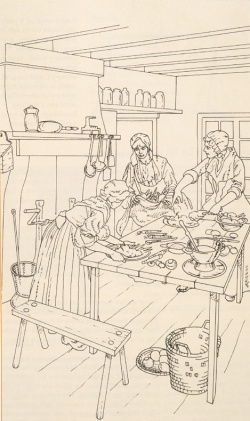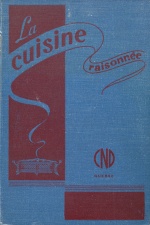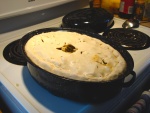Lac-Saint-Jean «Tourtière»
par Lemasson, Jean-Pierre
Tourtière [a specialty meat pie from the Lac-Saint-Jean region] is undoubtedly the dish that is most emblematic of the Province of Quebec. Although it is less a part of the daily diet today than in previous decades, it is still served and enjoyed on special occasions-particularly during the holiday season. Nonetheless there is an ongoing debate between those who consider the Lac-Saint-Jean recipe as the only authentic tourtière and those who consider the tourtière to simply be a modest-sized dish that closely resembles the traditional meat pie. In fact, the typical Lac-Saint-Jean tourtière consists of a rolled-dough bottom crust placed in a large relatively deep casserole dish which is then filled with pieces of meat and sometimes potatoes and finally covered with a dough crust. The "tourtière/meatpie", on the other hand, is a much simpler dish composed of a top and bottom crust filled with a ground beef preparation. Despite their differences, these two versions of the tourtière share a common origin that goes back quite a long ways. Over the centuries, the two types of tourtière have often crossed paths, thereby creating a strong Quebec culinary tradition.
Article disponible en français : Tourtière du Lac-Saint-Jean
The Origins and European Variations of the Meat Pasty
Tourtière is, along with soup, one of the earliest dishes known to humanity. Clues to the existence of gastronomy in antiquity were found in the form of three recipes dating back to 1600 BC. They were recorded on clay tablets in Mesopotamia (Modern-day Iraq), which Jean Bottéro (NOTE 1) was able to translate. The recipe, known as "Small fowl pie" contains the same fundamental ingredients as today's tourtière: some kind of meat filling between an upper and lower crust of dough. This dish was eaten by the kings and princes of the era. Centuries later, around 400 AD, another form of tourtière is found under the Latin name Patina [pasty] in a famous cookbook, the De Re Coquinaria, which is said to have been written by a Roman noble named Apicius (NOTE 2).
"Take the cooked sow teat (cut into pieces), cooked fish meat and cooked chicken meat. Grind the mixture carefully. Take a bronze mould, break the eggs in a pot and beat them. Place it in a mortier with pepper and lovage [plant of the parsley family]. Crush them [finely], add garum, wine, raisin wine and a little oil. Pour it into the pot and bring to a boil. Thicken after boiling. Put the meats that you have ground into the sauce. Place a layer of dough in the bottom of the bronze mould and then a full ladle of meat. Sprinkle with oil and cover with a layer of dough. Alternate the layers of dough and the layers of filling. Place a leaf pierced with a hollow reed on the top of the pastry. Turn the whole dish upside-down on a platter [and remove the mould], sprinkle with pepper and serve."
Besides the seasonings which often vary, there is an undeniably noticeable resemblance between Apicius' Patina and the present-day recipe for the Lac-Saint-Jean tourtière. There is a deep mould into which a dough lower crust is placed and filled with various kinds of meat, over which another layer of dough is placed.
The Middle Ages was the golden age of the meat pasty or pie. Here one must mention that the term "tourtière" designates the cooking dish and not the pasty itself (and the term is still used as such in certain countries). During the Middle Ages, meat pie recipes, which today would be the envy of most Saguenay residents, were passed from kitchen to kitchen throughout Europe. In Italy during the 1500's, parmesan meat pie was quite popular. It was composed of six layers of rare meats separated by pitted dates. England and France were no exception. In these countries the "tourte parménienne" [parmesan pasty] took on the appearance of a fortified castle with an elaborate crust filled with chicken, pork and lamb, decorated with the flags of noble knights (NOTE 3).
In addition to these aristocratic meat pies, there were also more modest variations made with ground meat and seasonings, cooked between two layers of plump crust. Popular food sold in sold in city meat shops or by mobile vendors, the meat pie was eaten at any time of day. In the rural countryside, it was also a highly appreciated dish, which was cooked over live embers in an earthenware or a metal dish that was the ancestor of today's tourtière dish (NOTE 4).
As Alberto Capatti once said "the tourte is a dish which appears to have been popular at all levels of society. Extremely practical, easy to make and preserve, seemingly easily available to all and ever offering a resemblance of civilised gastronomy, it has a wide variety of uses, it comes in a variety shapes and forms (the filling can be more or less complex, more or less costly) and it can be cooked in a number of ways. (NOTE 5).
TheTourtière Makes its Début in New France.
With successive links with French and English culinary tradition, this dish made its way to America at various times and in various ways. In fact, French and English influence, far from opposing each other, combined to create an entirely new kind of culinary heritage.
There is no doubt that an early version of tourtière was frequently eaten in New France, as there are references to the dish mentioned in various writings and as the presence of numerous moulds found on various sites seem to suggest (NOTE 6). These cooking dishes were usually used to make the popular meat pasty-style recipe, with the exception of some of the more aristocratic varieties prepared for Jean Talon and Louis de Buade de Frontenac, who had visited the court of the Sun King [Louis the 14th of France] and followed the trends of the royal court. What the meat pie had lost in size, it gained in refinement under the influence of the famous French Cook known as La Varenne [François Pierre] and his book Le Cuisiner François (NOTE 7). While the Tourte (or meat pasty) gradually disappeared from French cookbooks, it became more and popular in English cookbooks with the appearance of numerous variations of meat pie. It would not be an exaggeration to say that the central place of the tourte in Quebecois culture is a direct consequence of English dominance and their culinary customs.
However, English influence is did not only increase the meat pie's culinary value, for it would eventually also have influence on the popularity of the Lac-Saint-Jean tourtière. At first glance, such an affirmation would seem astonishing because the Lac-Saint-Jean region began to be settled around the 1850's. Though many hypotheses exist to explain the origins of the Lac-Saint-Jean tourtière, the most probable is the one based on the migration of the cipaille [or sea-pie].
Cipaille and Lac-Saint-Jean Tourtière
Many cookbooks-such as La Cuisine Raisonnée (NOTE 8) indicate that cipaille is of English origin (its name being derived from the similarly pronounced "sea pie"). The first cookbook published on the North American continent by Amelia Simmons (NOTE 9) contains a recipe for Sea Pie. The following is an excerpt from the 1796 edition:
"Four pounds of flour and one and a half pounds of butter mixed together. Wet with cold water and place the dough in the dish. Spread the cuts of pigeon and pieces of turkey (NOTE 10), veal, sheep, or birds with the slices of pork, salt, and pepper. Powder it with flour. Continue until the dish is full or the ingredients have been used up. Add three pints of water. Cover carefully with dough and let cook moderately two and half hours."
There are two characteristic traits. First of all, no ingredients come from the sea! This unusual observation is the object of further research. Second, the composition of the dish resembles that of the European aristocratic meat pie as well as that of the Lac-Saint-Jean tourtière. The exception is the predominance of the rare or exotic fowl (crane, peacock, etc.) in the earlier version.
The manner in which the Sea Pie crossed the border is unknown, but many hypotheses exist. However, cultural exchanges on the east coast were frequent, especially by sea. The Sea Pie would have arrived in the Gaspé, and the English name would have been changed to cipaille, cipâte, cipaye and other forms. One interesting fact is the various semantic transformations the name underwent, for locals came to believe that the preparation required six layers of meat (cipâte sounds like six pâtes or six layers of dough). In the Gaspé versions of the cipaille, there are, in fact, six layers of dough or six pies piled on top of each other. There are also versions that have no layers of dough but rather rows of meat. Other versions have potatoes added, which is a direct result of English influence. Here is a typical description of cipâte taken the book by Lorraine Boisvenue, entitled "Cipâte de ma grand-mère" (NOTE 11):
"Remove the bones from the chicken, partridge and the hare and cut all the meat (besides the previous mentioned, beef, veal, fresh pork, and goat) into cubes except for the salted fat (lard). Mix spices and onions. Add the spices to the meat and mix well. Cover and marinate in a cool place during the night. Cut the lard into small cubes and melt them in a large pot. Remove from heat and place a row of meat and onions and a row of potatoes. Cover with a layer of dough and make a hole in the centre. Repeat until ingredients have been used up. Cover with a thick layer of dough and make a hole in the centre. Pour the hot broth into the hole until even with the upper level of dough. Cover and put into the oven. Bake for 7 hours at 120 degrees Celsius. Add hot broth as needed while baking."
Cipaille is popular all over the Gaspé and numerous variations can be found in Lower Saint Lawrence region (NOTE 12). Interestingly, there are also recipes of cipaille for dessert that are sweetened using a fruit base.
Cipaille crossed the Saint Lawrence River and conquered the Côte Nord region. Did it migrate with the people from the Lower Saint Lawrence or was it imported in to the region due to commercial trade or marriages between families from the north and south banks of the St. Lawrence? No one can say for certain but one thing is sure: cipaille is also made in Charlevoix and in the Côte Nord region (NOTE 13). Cipaille also made its way to Saguenay and Lac-Saint-Jean with the settlers. This is where the meal truly acquired its identity as "La Tourtière du Lac-Saint-Jean". This name, which is now widely recognised, is the result of a relatively recent process. In fact, the term "Cipaille du Lac-Saint-Jean" was used during the first decades as the region was being settled. The expression "Tourtière duLac-Saint-Jean" developed somewhat later.
One of the first Quebec cookbooks, "Vers une Nouvelle Cuisine Québécoise", is very eloquent on the subject of tourtière: "In Canadian cooking, not a day goes by without someone claiming ownership of the ‘Cipaille du Saguenay' (NOTE 14). Nevertheless, the dish is actually called Tourtière Saguenéenne, which is a sign of changing culinary terminology.
In order to put a date on the use of the term Tourtière du Lac-Saint-Jean, it is necessary to examine old cookbooks. The recipes reveal that "tourtière-meat pie" preceded other forms of the dish, but it also reveals that the expression "Tourtière du Lac-Saint-Jean" is completely absent from these books. However, the term cipaille, also called "ancien pâté canadien" [Old-Fashioned Canadian Meat Pie], has been frequently used since 1943 in books such as "La Cuisine Raisonnée".
In addition, the first Canadian cookbook, "La Cuisinière Canadienne" (NOTE 15), contains many recipes of various kinds of meat pies. However, all these recipes, regardless of their how they might be named, are significantly smaller than the Lac-Saint-Jean version of the tourte. This is also the case of the dishes described in the cookbook "Directions Diverses de la Révérendes Mère Caron" (NOTE 16). At the time when these books were being published, the settlement of Saguenay had already started. However, even later, the term Tourtière du Lac-Saint-Jean still was not mentioned in the first edition of La Cuisine Raisonnée published in 1919 (NOTE 17).Though it contained recipes for meat pies and tourtières, they were made of fresh pork, fowl, and various kinds of fish. None resembled the classic Saguenay version of the recipe. Oddly enough, the first mention of the "Tourtière du Lac-Saint-Jean" would not appear until 1970 (NOTE 18).
It seems that the Tourtière du Lac-Saint-Jean was a dish that took its inspiration from the well-known cipaille, but came to be known under a different name. Furthermore, it no longer contains several superimposed levels of ingredients. Nevertheless, to this day in the Lac-Saint-Jean region, people still eat a dessert originally from the Lower Saint Lawrence River region called cipaille, which is made with several different layers.
A Complex Culinary Heritage
The Tourtière du Lac-Saint-Jean is thus a relatively new culinary innovation. It developed from previous versions of the meat pie and the English name "Sea Pie". However, these older versions have gradually disappeared and it eventually led to the creation of a new recipe. This is a case of a French adaptation of a dish brought to the New World by English settlers. It is not surprising that this dish has a special status. It renews the link between older aristocratic versions of the meat pie and the more popular versions of its predecessors. Though it has many differences, we cannot ignore ther emarkable continuity in its development from its origins to its famous presentday form.
Jean-Pierre Lemasson
Specialist in Quebec Culinary Heritage
Département d'études urbaines et touristiques
École des sciences de la gestion, Université du Québec à Montréal
Additional DocumentsSome documents require an additional plugin to be consulted
Images
Document PDF
Hyperliens
- « Tourtière, pâté à la viande ou cipaille? » (Reflets d'un pays, Radio-Canada) [French only]
- History of Canadian Cookbooks (Library and Archives Canada)
Catégories
Notes
1. Jean Bottéro, La plus vieille cuisine du monde, Paris, Éditions Audibert, 2002, 202 p.
2. Apicius, L'art culinaire, Paris, Éditions les belles lettres, 2002, p.37.
3. Barbara Ketcham Wheaton, L'office et la bouche, Paris, Calmann Levy, 1984, p. 296.
4. Liliane Plouvier, L'Europe à table, Bruxelles, Éditions Labor, 2003, Tome 2, p. 38.
5. Alberto Cappatti et Massimo Montanari, La cuisine italienne, Paris, Éditions du Seuil, 2002, p. 92-93.
6. Bernard Audet, Se nourrir au quotidien en Nouvelle-France, Québec, Éditions GID, 2005, 246 p., et Jacques Rousseau, L'œuvre de chère en Nouvelle-France, Québec, Presses de l'Université Laval, 1983, 447 p.
7. La Varenne, Le cuisinier françois [1651], Éditions Manucius, fac-similé de l'édition de 1651, Houilles, 2002.
8. From the 1943 edition of the recipe for cipaille, the name is clearly written in the subtitle of the recipe (Etymology: seapie, English), otherwise known as the ancien pâté canadien.
9. Amelia Simmons, The first American cookbook, Facsimile of the 1796 edition. Dover publications Inc., New York, 1984, 47 p.
10. The English version says Turkey Pie, which leads one to believe that the turkeys may have been wild.
11. Lorraine Boisvenue, Le guide la cuisine traditionnelle québécoise, Montréal, Éditions Stanké, 1979, p.166.
12. Charles Gagné, Recettes typiques de la Gaspésie et des Îles de la Madeleine, Montréal, Léméac, 1973.
13. For an example, see : Cuisinons à la Cayenne, 1988, Cercle des fermières du Havre-Saint-Pierre.
14. Institut de tourisme et d'hôtellerie du Québec, Vers une nouvelle cuisine québécoise, Éditeur officiel du Québec, 1977, p. 24-25.
15. La cuisinière canadienne, Montréal, Beauchemin et fils éditeur, 1879, 270 p.
16. Directions diverses données en 1978... Révérende mère Caron, Montréal, 1907, 296 p.
17. Manuel de cuisine raisonnée, Québec, École normale de Saint-Pascal, 1919, 410 p.
18. Refer to: Pinereau by Cécile Roland Bouchard, published in 1971 by Leméac or the publication already cited by Lorraine Boisvenue.
Bibliographie
Audet, Bernard, Se nourrir au quotidien en Nouvelle-France, Québec, Éditions GID, 2005.
Boisvenue, Lorraine, Le guide la cuisine traditionnelle québécoise, Montréal, Éditions Stanké, 1979.
Bottero, Jean, La plus vieille cuisine du monde, Paris, Éditions Audibert, 2002.
Gagné, Charles, Recettes typiques de la Gaspésie et des Îles de la Madeleine, Montréal, Léméac, 1973.
Ketcham Wheaton, Barbara, L'office et la bouche, Paris, Calmann Levy, 1984.



![A copper tourtière [meat pie dish] of French origin (18th century). For a long time in Canada (and to this day in France) the word tourtière referred to a cooking dish rather the pasty itself. © Musée Stewart au fort de l'île Sainte-Hélène.](/media/thumbs/386/300x0-Tourtiere18esiecle.jpg)






